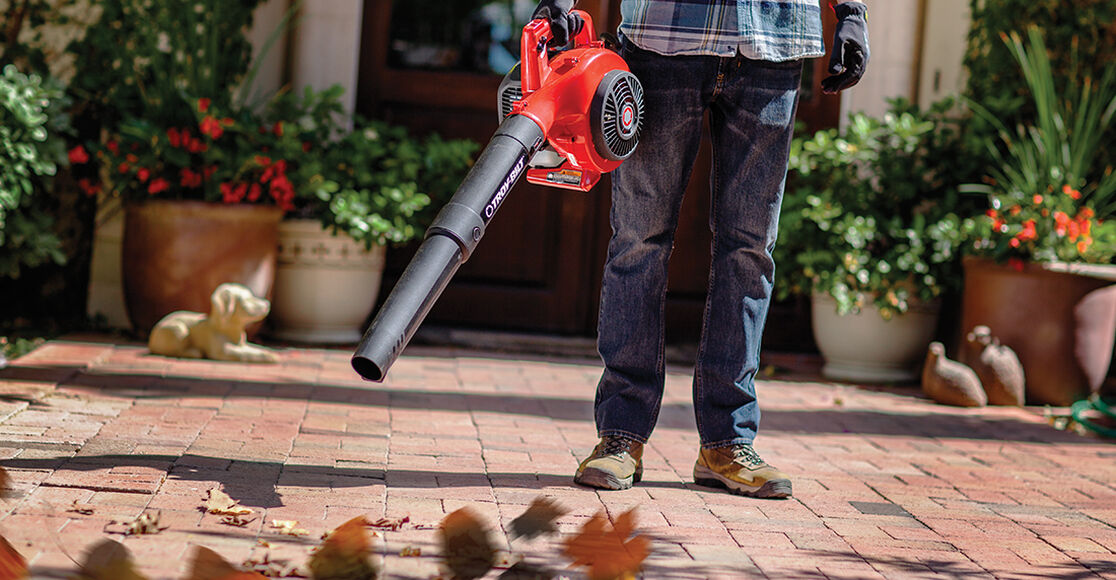Removing leaves from your yard in the fall not only keeps your lawn looking clean and beautiful throughout the season, but it also helps keep your lawn healthy. In fact, allowing a layer of leaves to remain on your grass throughout winter can actually damage your lawn.
Fortunately, there are many options when it comes to leaf removal, ranging from rakes to leaf blowers to vacuums. And when it comes to what to look for in a leaf blower, it helps to know what leaf blower features will work best for you, considering your yard and the amount of leaves you need to clear, as well as the amount of effort required. Here’s what you need to know on how to pick a leaf blower that’s best for you.
About Leaf Blowers
Leaf blowers are generally easy to use and make for a timesaving way to clear leaves from your lawn, especially compared to raking. Depending on the type of leaf blower you choose, backpack or handheld, you may also be able to use the blower to clear other debris, such as small sticks, dirt or wet leaves.
About MPH and CFM
Two measurements are often used to rate the power and speed of leaf blowers: miles per hour (mph) and cubic feet per minute (cfm). And the higher these two numbers, the more blowing power the unit will have.
The mph measurement tells you how fast air comes out of the leaf blower and is more helpful for moving heavier leaves. Meanwhile, cfm measures the volume of air a blower can move in one minute. A higher cfm may translate to the ability to move more leaves at once.
What Type of Drive System Do You Need?
Another consideration to make when buying your next leaf blower is whether you need a blower that is held or pushed. When choosing, consider the size of your yard, as well as the number of leaves you’re dealing with and the amount of physical effort that may be required to fully clear your lawn.
- Handheld leaf blowers are designed to be portable and used with one hand. In most cases, handheld leaf blowers are best for small- to mid-sized yards and come in electric, 2-cycle and 4-cycle options.
- Backpack gas leaf blowers and handheld gas leaf blowers can differ when it comes to power and features. Generally, backpack leaf blowers are more powerful than handheld blowers and are designed to be more comfortable for extended periods of use. They often feature fully tensioned suspension systems that evenly distribute the leaf blower’s weight across the user’s back. With features like these, gas-powered backpack leaf blowers can help mitigate usability issues that can come with long-term use of handheld gas, battery and electric handheld leaf blowers. For example, the TB51BP Backpack Leaf Blower is designed with comfort features like padded shoulder straps, a harness, and a chest strap to help evenly distribute the blower’s weight while operating. This blower also has a 2-cycle engine.
As a rule of thumb, small- to medium-sized yards call for handheld leaf blowers. This type of blower can vary in power but is useful for clearing leaves from tight areas around the yard. Larger yards tend to call for backpack blowers because they’re built to produce greater power for heavy duty cleanup jobs.
To clear leaves efficiently from your yard, place a tarp over a designated area on your lawn. Using a leaf blower, blow the leaves into a pile on the tarp, gather up the corners, and leave the bundle out by the curb for pickup according to your city’s green waste rules, or move the leaves to a compost pile or vegetable garden if you’re looking for an eco-friendlier option.
Throughout the fall, your yard needs to breathe to receive the nutrients and sunlight it needs to thrive come springtime. Try to remove your leaves every other week to help maintain a healthy lawn.
And what should you do with collected leaves? There’s no need to landfill them because they can be recycled. You can use a mulching mower to add shredded leaves back to your lawn. As they break down, they act as a natural fertilizer that helps maintain healthy grass. Mulched leaves can also be used as mulch around flowers, trees and shrubs for the same purpose. (Just make sure leaves are mulched or shredded before using.)
Composting shredded leaves with grass clippings is another great way to recycle leaves. This step can be saved for spring fertilizing too.
